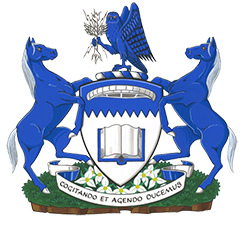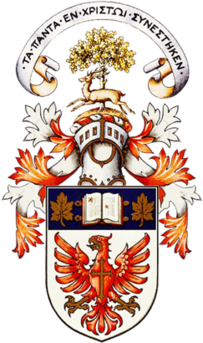
Indian Institute of Technology Kanpur is a public technical and research university located in Kanpur, Uttar Pradesh. It was declared to be an Institute of National Importance by the Government of India under the Institutes of Technology Act.

A supercomputer is a computer with a high level of performance as compared to a general-purpose computer. The performance of a supercomputer is commonly measured in floating-point operations per second (FLOPS) instead of million instructions per second (MIPS). Since 2017, there are supercomputers which can perform over a hundred quadrillion FLOPS. Since November 2017, all of the world's fastest 500 supercomputers run Linux-based operating systems. Additional research is being conducted in China, the United States, the European Union, Taiwan and Japan to build faster, more powerful and technologically superior exascale supercomputers.
In computing, floating point operations per second is a measure of computer performance, useful in fields of scientific computations that require floating-point calculations. For such cases it is a more accurate measure than measuring instructions per second.

Blue Gene is an IBM project aimed at designing supercomputers that can reach operating speeds in the petaFLOPS (PFLOPS) range, with low power consumption.
The Sheridan College Institute of Technology and Advanced Learning, previously called Sheridan College of Applied Arts and Technology, commonly known as Sheridan College, is a diploma, certificate and degree-granting polytechnic institute in Ontario, with approximately 23,000 full-time students and 17,000 continuing education students. Founded in 1967, the college offers programs in animation and illustration, creative writing and publishing, music theatre, film and design, business, applied computing, engineering technology, community studies, and liberal studies. There are campuses in Oakville, Brampton, and Mississauga.

The Regional Municipality of Durham, informally referred to as Durham Region, is a regional municipality in Southern Ontario, Canada. Located east of Toronto and the Regional Municipality of York, Durham forms the east-end of the Greater Toronto Area and the core part of the Golden Horseshoe region. It has an area of approximately 2,500 km2 (970 sq mi). The regional government is headquartered in Whitby.

Quadrics was a supercomputer company formed in 1996 as a joint venture between Alenia Spazio and the technical team from Meiko Scientific. They produced hardware and software for clustering commodity computer systems into massively parallel systems. Their highpoint was in June 2003 when six out of the ten fastest supercomputers in the world were based on Quadrics' interconnect. They officially closed on June 29, 2009.

The University of Ontario Institute of Technology, corporately branded as Ontario Tech University or Ontario Tech, is a public research university located in Oshawa, Ontario, Canada. Ontario Tech's main campus is located on approximately 400 acres (160 ha) of land in the northern part of Oshawa. It operates a secondary campus in the downtown area of Oshawa.

Mohawk College of Applied Arts and Technology is a public college of applied arts and technology located in Hamilton, Ontario, Canada. It has three main campuses: the Fennell Campus on the Hamilton Mountain, the Stoney Creek Campus in Stoney Creek, and the Mohawk-McMaster Institute for Applied Health Sciences at McMaster University. As of 2014 more than 1000 faculty instruct roughly 12,500 full-time students, 4,000 apprentices, 46,000 continuing education registrants and 1,800 international students studying in more than 130 post-secondary and apprenticeship programs. Since its founding in 1966, over 115,000 students have graduated from Mohawk College.

McMaster University is a public research university in Hamilton, Ontario, Canada. The main McMaster campus is on 121 hectares of land near the residential neighbourhoods of Ainslie Wood and Westdale, adjacent to the Royal Botanical Gardens. It operates six academic faculties: the DeGroote School of Business, Engineering, Health Sciences, Humanities, Social Science, and Science. It is a member of the U15, a group of research-intensive universities in Canada.

Chemnitz University of Technology is a public university in Chemnitz, Germany. With over 11,000 students, it is the third largest university in Saxony. It was founded in 1836 as Königliche Gewerbeschule and was elevated to a Technische Hochschule, a university of technology, in 1963. With approximately 1,500 employees in science, engineering and management, TU Chemnitz counts among the most important employers in the region.
In 2005, the McMaster School of Computational Engineering and Science was the first program launched in Canada dedicated in developing expertise in the third wave of scientific research involving simulation, modeling and optimization. The new school brings together 50 faculty from engineering, science, business and health science to collaboratively conduct research and advance education.

The TOP500 project ranks and details the 500 most powerful non-distributed computer systems in the world. The project was started in 1993 and publishes an updated list of the supercomputers twice a year. The first of these updates always coincides with the International Supercomputing Conference in June, and the second is presented at the ACM/IEEE Supercomputing Conference in November. The project aims to provide a reliable basis for tracking and detecting trends in high-performance computing and bases rankings on HPL, a portable implementation of the high-performance LINPACK benchmark written in Fortran for distributed-memory computers.
Expenditures by Canadian universities on scientific research and development accounted for about 40% of all spending on scientific research and development in Canada in 2006.

Higher education in Ontario includes postsecondary education and skills training regulated by the Ministry of Colleges and Universities and provided by universities, colleges of applied arts and technology, and private career colleges. The current minister is Ross Romano who was appointed in June 2019. The ministry administers laws covering 22 public universities, 24 public colleges, 17 privately funded religious universities, and over 500 private career colleges. 18 of the top 50 research universities in Canada are in Ontario.
This article outlines the history of natural scientific research in Canada, including physics, astronomy, space science, geology, oceanography, chemistry, biology, and medical research. Neither the social sciences nor the formal sciences are treated here.

In computing, petascale refers to a computer system capable of reaching performance in excess of one petaFLOPS, i.e. one quadrillion floating point operations per second. The standard benchmark tool is LINPACK and Top500.org is the organization which tracks the fastest supercomputers. Some uniquely specialized petascale computers do not rank on the Top500 list since they cannot run LINPACK. This makes comparisons to ordinary supercomputers hard. The petaFLOPS barrier was first broken in September 16, 2007 by the Folding@home project, used to fold proteins for medical research. Petascale supercomputers are planned to be succeeded by Exascale computers.

SciNet is a consortium of the University of Toronto and affiliated Ontario hospitals. It has received funding from both the federal and provincial government, Faculties at the University of Toronto, and affiliated hospitals.
Exascale computing refers to computing systems capable of calculating at least 1018 floating point operations per second (1 exaFLOPS). The terminology generally refers to the performance of supercomputer systems and no single machine has reached this goal. As of June 2020 there are systems being designed to reach the milestone of one exaFLOPS. In April 2020 the distributed Folding@home computer network attained one exaFLOPS of computing performance.
Hossein Rahnama is a recognized figure in ubiquitous and pervasive computing. His research explores artificial intelligence, mobile human-computer interaction, and the effective design of contextual services. In 2017, Hossein was recognized as one of Canada’s Top 40 Under 40. In 2012, he was recognized by the MIT Technology Review as one of the world’s top innovators under the age of 35 for his research in context-aware computing. The Smithsonian named Hossein as one of the top six innovators to watch. Hossein has 30 publications and 10 patents in ubiquitous computing, is serving on the board of Canadian Science Publishing, and was a Council Member of the National Sciences and Engineering Research Council (NSERC). Hossein is also a visiting scholar at the Human Dynamics group at MIT Media Lab in Cambridge, MA. He has a PhD in Computer Science from Ryerson University.












